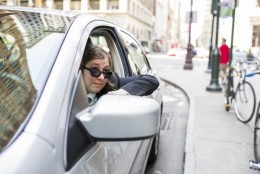Posing As An Uber Driver Means Overhearing Great Convos About Prenups

When Philly CityPaper journo Emily Guendelsberger went undercover as an UberX driver, she learned some amazing things, including what a man says to his fiancee when he is trying to convince her to sign a prenup.
Two good-looking young strangers are having an amazing conversation in the backseat of my car. I’m eavesdropping so hard I nearly run a red light.
Her: Then don’t make me sign it. Ugh, it’s like you’re planning for this not to work.
Him (stammering): No, I just think that, the idea is that …
Her: I mean, what’s the benefit for me in signing one?
Him (after a long pause): I mean, that you’re still going to be able to get married.
Those crazy kids are going to make it work, I just know it.
After some initial weirdness in set up — Uber, it seems, gives you even less preparation for the real world than Teach for America! — Guendelsberger has some good experiences as a driver:
Once I make it to my first passenger, though, he’s a delight. He’s an older union guy who’s lived within three blocks of me in our Fishtown neighborhood for his whole life. “Wow, I’ve never gotten a woman driver before!” he says. My neighbor says he loves Uber because, even now, you can never get a cab up here. He tells me stuff about Fishtown in the ’60s. As I let him off at 30th Street Station, he waves goodbye and thanks me, and says he’s rating me five stars. The fare pops up on my phone: $10.85. The price of almost two beers for 15 minutes of driving! And if my neighbor had taken a cab, with tip, it would have been an even $20. …
I maintain a perfect five-star rating for my first few days, of which I’m weirdly proud. I do get the idea, though, that I’m benefiting from my novelty value as a female driver, natural chattiness and, most important, being from the same social caste as most of my passengers. Several mention their relief at getting a driver who’s a native English-speaker, saying Uber has been going downhill lately.
These days, cab drivers and Uber drivers look a lot alike.
There’s a good reason for that. When Uber first enters a market, apparently, it pays well, enticing suit-wearing, water-bottle-distributing English speakers to take up driving, at least in their spare time. Then, once competition picks up, in the form of Lyft and so on, Uber slashes fares. Here’s how Emily described that process to a passenger who asked her whether it’s true that Uber drivers make lots of money.
So then Uber cuts fares down by, like, a lot. Like, here, they just cut fares almost in half. So most of those initial drivers quit and are replaced by people willing to work for the lower amount, who are the same people who used to drive cabs. They’re just doing it for a new boss, for less money and no tips, and they’re carrying most of the liability themselves. But most riders never change that first impression that drivers make a lot of money.
The liability question is an interesting one. What company covers these PT drivers? Many drivers assume their personal insurance continues to cover them while they’re taxiing strangers around town; according to the insurance reps that Emily speaks to, though, that might not be the case.
Uber reassures drivers that they’ve got them covered, but their vaunted $1 million policy is secondary for collision — that is, drivers must try to get their own insurance companies to pay the claims first. If the claim is rejected because the insurer figures out it’s Uber-related, then Uber’s policy kicks in — but the driver’s almost certainly going to have his personal insurance policy cancelled, and in some cases be investigated for fraud. …
“The problem is some insurance companies are saying, ‘As soon as you log on with your app, you’re using your car commercially’” — that is, if you’re hurrying to pick someone up but don’t have a passenger yet, there’s a possibility that the driver will be covered by neither policy in an accident.
Well, what’s life without a little risk, I guess?
Her conclusion:
After 100 rides, I felt like I had enough [data] to work with. Over that duration, during which I maintained a 4.83 adjusted rating, high enough to qualify me for Uber’s VIP program, Uber would say I “earned” $17 an hour in gross fares. But subtract the 28 percent that went to Uber and the 19 percent that went to expenses, and I actually made $9.34 an hour (plus a grand total of $16 in tips, $10 of which were for meeting up with a guy who left his Porsche keys in my backseat).
Driving for UberX isn’t the worst-paying job I’ve ever had. I made less scooping ice cream as a 15-year-old, if you don’t adjust for inflation. If I worked 10 hours a day, six days a week with one week off, I’d net almost $30,000 a year before taxes.
But if I wanted to net that $90,000 a year figure that so many passengers asked about, I would only have to work, let’s see …
27 hours a day, 365 days a year.
Support The Billfold
The Billfold continues to exist thanks to support from our readers. Help us continue to do our work by making a monthly pledge on Patreon or a one-time-only contribution through PayPal.
Comments